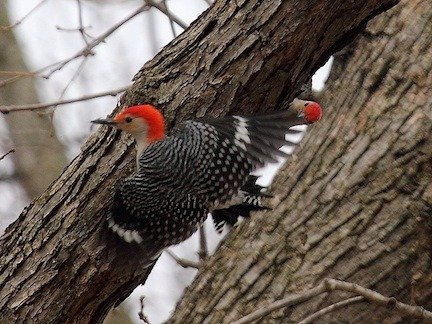





Among the collective names for a group of woodpeckers is a ?drumming?. This seems especially appropriate for the red-bellied woodpecker, a species with its own special form of percussion.
Name
The description “red-bellied” is something of a misnomer. This bird’s most highly visible patch of red coloring appears on the back of its neck; only a small, barely-noticeable patch of red can be seen on its underside. Unlike the more rare red-headed woodpecker, whose entire head is bright red, the red-bellied woodpecker’s head is mostly pale with just a wash of color.
Appearance
Measuring about 10 inches, the red-bellied woodpecker bears distinctive black-and-white barred patterning on its back and has a long, chisel-shaped beak. Males are nearly 10% larger than females. The male also features a red patch extending from the bill to the base of the neck, while the female has red coloring on the neck only. On both sexes, the face and most of the belly is a a dull buff color. Red-bellied woodpeckers retain the same coloring throughout the year.
Unlike most other birds, this species has two toes forward and two toes back (most bird have three toes forward and one toe back). This special anatomical feature allows it to climb straight up a tree trunk.
Range/Habitat
These woodpeckers are common in forested areas, particularly those with old hardwood trees, throughout the East and Midwest. They are frequent visitors to parks and wooded back yards. Although they don’t usually migrate, individuals in more northern regions may travel somewhat further south during very cold winters. Red-bellied woodpeckers are solitary birds, except during the mating season.
Food
Acorns, beechnuts, pinecones and fruits are favorite wild foods of the red-bellied woodpecker, which often stores tidbits in tree crevices, saving them for later consumption. Omnivorous, this bird also consumes wood-boring beetles, grasshoppers, caterpillars and ants. It is even known to eat small vertebrates such as anoles and tree frogs.
Sounds
During their breeding period, these woodpeckers make a loud, repeated “churrr”, as well as a “chuck-chuck-chuck” sound. They also famously communicate by rapidly beating their beaks, or “drumming”, on dead trees, utility poles, or even house siding, roofs and gutters. This is how males to establish their territories. It also allows breeding pairs to signal each other. Although the ruckus might alarm homeowners, as far as the birds are concerned, the more resonance created, the better. Hear some sounds of the red-bellied woodpecker here.
 Mating and Young
Mating and Young
In early spring, red-bellied woodpecker couples together begin excavating and building a nest in a tree cavity. They most often choose dead hardwood or pine trees, or dead limbs of live trees, but may also build a nest in a fence post. Although they often return to nest in the same tree year after year, the pair usually excavates a new hole each time. During nest-building time, couples often communicate by tapping, one inside and one outside the cavity. The female lays two to six smooth, white eggs, which are then incubated by both parents. Although fledglings leave the nest about 24 days after hatching, they are not yet independent. The adults remain close by for up to ten weeks, helping their young forage for food.
Behavior
The red-bellied woodpecker systematically scours the trunks and main branches of medium to large trees for insects, more often picking under the bark than actually drilling the wood. Males have a wider tongue tip and longer bill, allowing them to forage in deeper crevices than the females. This is why male red-bellied woodpeckers are most often seen on tree trunks, and females more often on limbs.
The birds’ characteristic movement is to lean away from a tree, using stiff tail feathers as a support, as they walk and climb its surface. This special method of tree scaling, called “hitching”, allows them to easily glean food beneath the surface of the bark.
Attracting to Your Yard
This species will visit backyard feeding stations, especially in the winter, for suet, peanuts and sunflower seeds. You can also attract red-bellied woodpeckers by planting berry-producing shrubs and by allowing some hollow or dead limbs to remain for use as nesting cavity sites.
For More Information:
Cornell Lab of Ornithology: All About Birds: Red-Bellied Woodpecker
Audubon: Red-Bellied Woodpecker
Photo Credits:
thumbnail photo by Mark Adams
red-bellied woodpecker pair by Mr.TinDC
Copyright © www.100flowers.win Botanic Garden All Rights Reserved